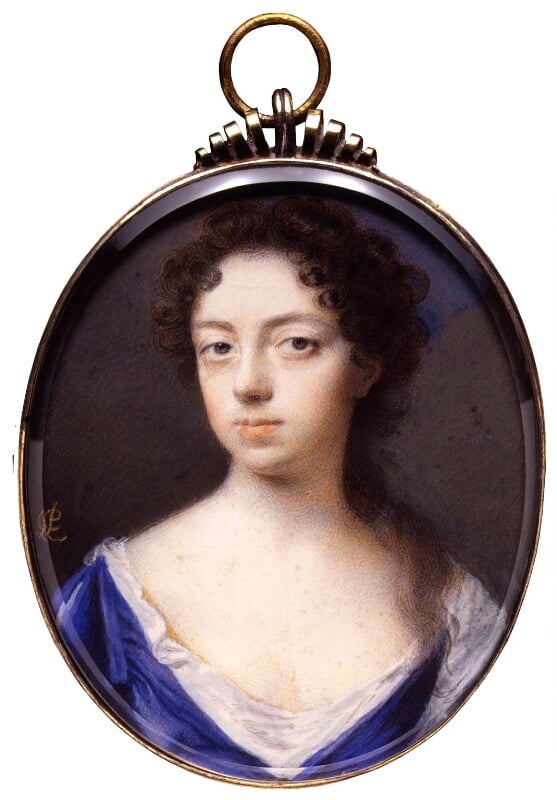Anne Finch, Countess of Winchilsea
- Overview
- Extended Catalogue Entry







© National Portrait Gallery, London
Anne Finch, Countess of Winchilsea
by Peter Cross
watercolour on vellum and card, circa 1690-1700
3 in. x 2 1/2 in. (76 mm x 64 mm) oval
Purchased, 1969
Primary Collection
NPG 4692
Sitterback to top
- Anne Finch, Countess of Winchilsea (1661-1720), Poet; wife of 5th Earl of Winchilsea. Sitter in 1 portrait.
Linked publicationsback to top
- 100 Pioneering Women, p. 33 Read entry
Anne Finch (1661-1720), acquaintance and contemporary of fellow Augustan poet Alexander Pope, is best known for her Pindaric ode and longest poem, The Spleen (1701), and for Miscellany Poems, on Several Occasions (1713). By the nineteenth century, William Wordsworth and other Romantics had come to see her as a kindred spirit. In the preface to Lyrical Ballads (1815), Wordsworth described her as one of the few Augustan poets to use ‘gentle imagination’ to describe ‘external nature’. She is among the first female poets ever published, writing not just verse but also prose and plays, all amid the difficulties of a woman navigating the male-dominated literary world. Born in Hampshire, daughter of Sir William Kingsmill, Finch was not only aristocratic but educated, too, her family being proponents of schooling for girls. A ‘gentle fighter’ is how twentieth-century poet Dilys Laing described her; a great advocate of social justice for women. She became Countess of Winchilsea in 1712, when her husband, Heneage Finch, became 5th Earl of Winchilsea.
- Ingamells, John, Later Stuart Portraits 1685-1714, 2009, p. 337
- Rogers, Malcolm, Master Drawings from the National Portrait Gallery, 1993 (accompanying the exhibition at the National Portrait Gallery from 5 August to 23 October 1994), p. 31
- Saywell, David; Simon, Jacob, Complete Illustrated Catalogue, 2004, p. 669
- Walker, Richard, Miniatures: 300 Years of the English Miniature, 1998, p. 49 Read entry
Lady Winchilsea was a friend of Alexander Pope, Jonathan Swift, John Gay and Nicholas Rowe, and was herself a poet. Her Miscellany of Poems on Several Occasions was published in 1713. The best-known poem in it, 'The Spleen', is a somewhat melancholic composition, perhaps reflecting (as described by Virginia Woolf in A Room of One's Own) her unappreciated position as a woman writer and disposition to depression.
Events of 1690back to top
Current affairs
William III, forced to leave England to fight in Ireland, empowers Mary II, through the Regency Act, to exercise authority in his absence. William, however, unwilling to rest power solely with Mary, appoints a council of nine statesmen directly answerable to the absent king.Art and science
Philosopher, John Locke, publishes An Essay Concerning Humane Understanding and Treatises on Government, in which he sets out his notion that human understanding is derived from experience.Naturalist, John Ray, publishes Synopsis methodica stirpium Britannicarum. It became the most consulted book for the classification of British plants.
International
William III lands in Ireland with an allied force of Protestant fighters from European states to fight French and Irish troops under James II. William's victory at the Battle of the Boyne forces James to flee into permanent exile.French defeat the English at the naval battle of Beachy Head.
Comments back to top
We are currently unable to accept new comments, but any past comments are available to read below.
If you need information from us, please use our Archive enquiry service . Please note that we cannot provide valuations. You can buy a print or greeting card of most illustrated portraits. Select the portrait of interest to you, then look out for a Buy a Print button. Prices start at around £6 for unframed prints, £16 for framed prints. If you wish to license an image, select the portrait of interest to you, then look out for a Use this image button, or contact our Rights and Images service. We digitise over 8,000 portraits a year and we cannot guarantee being able to digitise images that are not already scheduled.


